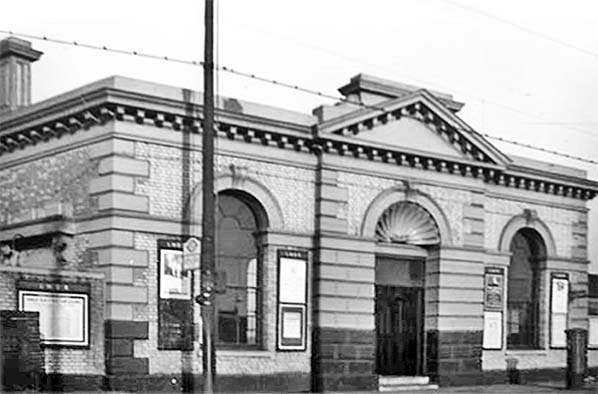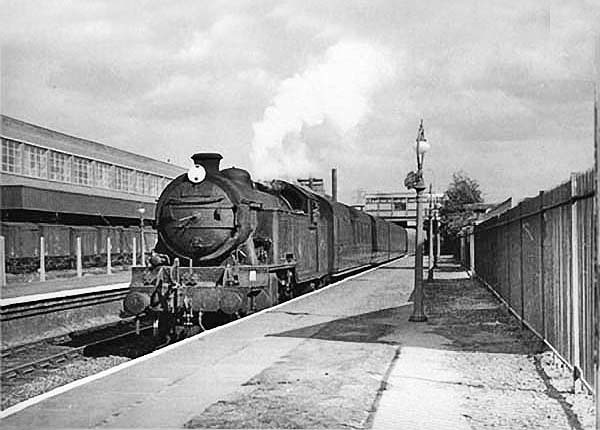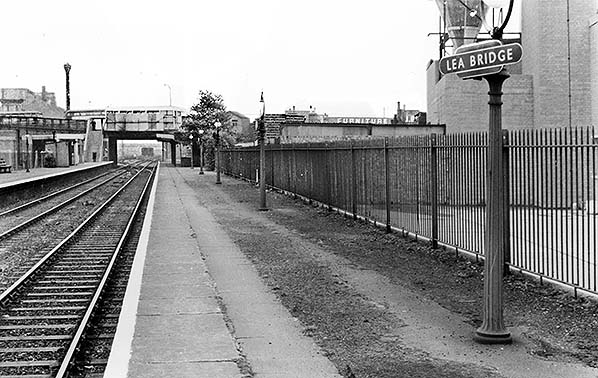
Lea Bridge Station Gallery 2: 1933 - July 1975

The street level building is seen in 1940. The building has lost its bell turret and the lamp above th entrance.
Photo from John Mann collection bridge_aerial_old6.jpg) Aerial view of Lea Bridge station from the south in April 1947. The street-level building was gutted by fire on 31 March 1944 and is seen here as a blackened shell. The staggered platform shelters are seen, the angle of the stagger matching the angle of the road in relation to the line. Lea Bridge signal box and junction is seen north of the up platform. Bottom right is the recently-built goods and parcel depot which was constructed partially on the site of the disused GER telegraph works. Note the high-level staff walkway linking the depot with the street-level station building. North of the goods depot is H Young & Co's steel fabrication works which moved onto the site of the cast stone works in 1939 following an air raid which destroyed Young's works at Nine Elms. The works are served by four sidings from Lea Bridge Junction. The sign on the side of the building reads ‘Powers and Deane Ransome's Co. Lea Bridge Steelworks. E10’. On the left, one of the stands of the abandoned Lea Bridge Stadium is seen. Part of the stationmaster's house is seen bottom left, next to the station building.
Click here for a larger version Reproduced with the kind permission of Simmons Aerofilms Ltd bridge_aerial_old12.jpg) Aerial view of Lea Bridge station from the east in April 1947. Lea Bridge Road runs along the left edge with the burnt-out and blackened shell of the station building clearly visible. The recently-constructed good/parcels depot is seen to the east of the station. Despite a number of vans in the sidings the yard is devoid of any activity with no vehicles visible. To the right the steel yard appears to be well stocked. The remains of Lea Bridge Stadium are seen at the top; the two stands are still there but the terracing a and track have been removed to allow the site to be used as allotments as part of the war effort. Further allotments are seen on railway land to the north of Lea Bridge Junction. There are some interesting buses on Lea Bridge Road. (Click here to see a larger version) Towards the bottom of the picture and heading east is a trolleybus. Between the trolleybus and the station, also heading east, is an LT class double-decker. Heading west and about to pass the station is an open-staircase bus, either of the LT or ST class. It appears to be an ST. In 1947 the LT and ST classes had only a couple of years left before they were replaced by the RT types. The surviving open-staircase buses had enjoyed an extended life owing to the war.
Reproduced with the kind permission of Simmons Aerofilms Ltd bridge_old8.jpg) Lea Bridge station looking south from the down platform in 1952. The electric lamp posts of distinctive LNER design are all displaying a British Railways Eastern Region totem sign. The final specification for totem signs was agreed in late 1949, allowing the first totems to be made and hung in 1950. The long goods dock is seen on the left as is the raised walkway from the upper level of the depot to the street-level building.
Photo received from Dave Brennand bridge_aerial_old14.jpg) An aerial view of Lea Bridge station seen from the north in June 1952. The street-level building has been repaired and now has a new roof. A trolleybus is seen approaching the station along Lea Bridge Road. At this time trolleybuses running along Lea Bridge Road were 555 Woodford (Sunday only) - Leyton Green - Bloomsbury. 557 Chingford Mount - Liverpool Street station. 581 Woodford (Napier Arms) - Bloomsbury. Two British Railways delivery vans, both in carmine and cream livery, are also seen in Lea Bridge Road. The stationmaster's house is seen to the right of the station with more railway land around it being used as allotments for the war effort. A line of vans stands at the goods depot loading dock and a line of road delivery vans is seen to the left. Lea Bridge Gas Works is seen top left.
Click here for a larger version. Reproduced with the kind permission of Simmons Aerofilms Ltd bridge_aerial_old7.jpg) An aerial view of Lea Bridge station seen from the west in June 1952. Powers & Deane Ransome's Co. Lea Bridge Steelworks and, next to it, the BR goods and parcels depot are seen to the east of the station. None of the other industries seen in this view are rail-connected. Click here for a larger version.
Reproduced with the kind permission of Simmons Aerofilms Ltd
 L1. No.67729 is seen at the down platform of Lea Bridge station circa late 1950s. 67729 was a Stratford machine for almost all its life. It is working a local service but its destination could be one of several places: Broxbourne; Hertford; Bishops Stortford; Cambridge.
Photo from Jim Lake collection bridge_old4.jpg)
Lea Bridge station looking south from the down platform in September 1963. Although repaired and re-roofed after fire damage during the war, the attractive street level building has now been demolished and replaced with a very plain prefabricated concrete structure. The up platform shelter has also been demolished and replaced with a concrete bus shelter. A line of vans is seen in the goods dock to the east of the station.
Copyright photo from Stations UK  Lea Bridge station looking south along the down platform circa early 1960s. A half-flanged totem sign is fitted to each of the LNER ‘mint imperial’ style electric lamp posts which remained in place until closure.
Photo from John Mann collection old18.jpg) Brush Class 31 D5666 arrives at Lea Bridge with a North Woolwich - Palace Gates train on 5 January 1963, the last day of the Palace Gates service. The loco was later renumbered 31239 in 1973 and again to 31439 in 1984 and survived in service until 31 October 2010. It was scrapped the following March by CF Booth of Rotherham.
Photo by David Pearson bridge_old2.jpg) Lea Bridge station looking south from the up platform in July 1975. The 'new' street level building is already looking very shabby by this time as is the bus shelter on the platform. The following year the station would become unstaffed. The only attractive feature of the station now is the LNER lamp standards with 'mint imperial’ shades.
Photo by Alan Young
bridge_old1.jpg) Lea Bridge Station looking south-east in July 1975. Although Lea Bridge officially closed to goods traffic on 7 December 1970 it was retained as a parcels depot, and vans are still seen at the dock in this 1975 view. The final closure date is not known but is assumed to be in the 1970s. Photo by Alan Young Click here for Lea Bridge Station Gallery 3: July 1975 - 1984
|

bridge_aerial_old13.jpg)

 Home Page
Home Page